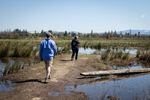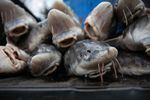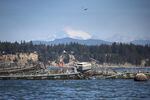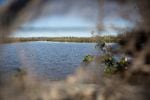
Luke Fitzpatrick and his mom, Kathy Bridges, walk the berms between fish ponds at Santiam Valley Ranch in Turner, Ore., Thursday, April 15, 2021.
Bradley W. Parks / OPB
While the word “farm” might conjure visions of corn planted in neat rows, Luke Fitzpatrick’s acreage looks, feels and functions more like wetlands. Chirps and squawks emanate from the ponds covering his patch of land just a short drive from Salem.
Fitzpatrick called out avian creatures by name as he maneuvered an off-road vehicle around the farm on a sunny Thursday this spring. Stilt sandpiper. Cinnamon teal. Western meadowlark, Oregon’s state bird.
He pulled to a stop, got out and dipped into a duck blind filled with decoy mallards and rolling desk chairs to gaze out over his crop growing beneath the glassy surface of the water.
“I’m tied to the land,” he said. “I love it out here.”

A pair of cinnamon teal swim on the surface of a pond at Santiam Valley Ranch in Turner, Ore., Thursday, April 15, 2021. The aqua farm looks, feels and functions as wetland habitat for migratory birds.
Bradley W. Parks / OPB
Fitzpatrick is a fish farmer. He raises and sells warm-water species like bass, bluegill, crappie and catfish through a practice called aquaculture. It’s basically just farming in water, and it’s used to grow a variety of finfish, shellfish and aquatic plants.
Aquaculture has become a much bigger part of the global food system in recent years. The world now produces more seafood on farms than it catches wild, by volume, and the fish farming industry is still growing rapidly.
The United States is the world’s leading consumer of farmed seafood. It’s also one of the smallest producers, but federal agencies and universities are investing millions of dollars in aquaculture research, development and technology to try to change that — and some in Oregon are hoping the state can cash in.
Started from the bottom
Fitzpatrick’s fish farm in Turner is one of the larger ones in Oregon, but his crops are mostly destined for people’s ponds rather than their plates.
While shellfish aquaculture has long held a place in the Northwest, other types of fish farming have historically been tough business here — especially in the Beaver State. Oregon ranks well behind neighbors California, Washington and Idaho in its production of food fish.
“The United States in general is kind of behind the curve a little bit,” said John Moehl, a McMinnville-based aquaculture specialist. “And Oregon, within the United States, is definitely behind the curve.”
Moehl spent nearly two decades with the Food and Agriculture Organization of the United Nations facilitating aquaculture development in Central and West Africa. Aquaculture in Oregon didn’t change much in that time.
That’s partly because the state established rules and laws intended to protect the integrity of the oceans off its coast, estuaries, and the inland waterways that twist and wind across the landscape. Both ocean mariculture and inland aquaculture have been tied to pollution, disease, invasive species and lax animal safety.
And so boxing out aquaculture in Oregon, directly or indirectly, has been seen as protective of the environment, wild fish stocks and commercial fishing.

Wild caught sturgeon are prepared for measuring near Hood River, Ore., Tuesday, March 3, 2020.
Bradley W. Parks / OPB
But as aquaculture becomes more important to food systems of the future, Moehl and other advocates see potential to grow the industry in Oregon — and to learn from other places that already have.
“We don’t have a lot of things to undo in order to develop a modern, state-of-the-art program,” Moehl said. “We’re at the bottom, but we can actually build now the best pathway to the top.”
How we’re here
A 2018 report from the World Resources Institute, backed by the United Nations and World Bank, says aquaculture production needs to more than double by 2050 to meet the seafood demands of 10 billion people and help restore wild fish stocks, a growing number of which are overfished at unsustainable levels.
Yet seafood production on U.S. aqua farms has remained pretty stagnant since the 1980s, when people had a much more critical view of the industry. (The late comedian Garry Shandling even joked about visiting a fish farm in his 1984 stand-up special “Alone In Vegas,” pretending to stamp on a sickly bass crawling on land in search of food.)
“There was a lot of controversy over whether this was good or bad for the environment,” said Roz Naylor, an economist and the founding director of the Center on Food Security and the Environment at Stanford University.
Naylor was the lead author on a paper in 2000 that warned aquaculture wasn’t sustainable in the long term, despite being a net contributor to world fish supplies. The paper won support of environmentalists and commercial fisheries, which saw aquaculture as a threat.

A damaged net pen at Cooke Aquaculture's facility on Cypress Island is shown on Tuesday, Aug. 22, 2017.
Megan Farmer / KUOW
Since then, as other food production sectors like beef have come into focus for their outsize contributions to climate change, aquaculture’s appeal has grown. Fish generally have fewer calories and saturated fat than red meat, and they have a lower carbon footprint than beef, poultry and pork.
THANKS TO OUR SPONSOR:
Naylor and a team of researchers published a new paper in the journal “Nature” this spring that looked at improvements in aquaculture since their inaugural study sparked controversy decades ago.
They found that the aquaculture industry has become significantly more efficient and sustainable. However sustainable it may be these days — especially when compared to other meat production chains — fish farming is still not ecologically benign, Naylor said. Many of the problems that plagued the industry when Shandling was delivering zingers on Showtime are the same problems it faces today: escapement, pollution, disease and pathogens.
The risks associated with aquaculture grow as the industry grows, Naylor said.
“We have to look at the experience that we’ve had with the industrial livestock sector,” she said. “As that has scaled, these kinds of issues have come up, and we would be foolish to be blind to those kinds of issues coming up [in aquaculture].”
Less is more
Washington state is giving up on farming Atlantic salmon in net pens after one collapsed in Puget Sound in 2017. Disease and market consolidation are shrinking the trout farming industry in Idaho.
Industrial fish farms probably won’t be dotting the Oregon Coast any time soon, but proponents still see room for aquaculture in the state.
According to the WRI report from 2018, feeding future generations will require humans to produce more food without mowing down forests, devoting more land to agriculture or squeezing our water sources dry.

A fish pond is pictured through a duck blind at Santiam Valley Ranch in Turner, Ore., Thursday, April 15, 2021.
Bradley W. Parks / OPB
Sustainable farming is a game of inputs (land, labor, water, fertilizers, etc.) and outputs (commodities). The goal is to reduce inputs and increase outputs. In other words, to get more with less.
“I’m trying to get more out of an existing box of resources,” said Moehl, from McMinnville. “Basically, we now know that our resources have finite limits, so we have to be able to multiply the benefits that we get from those finite supplies.”
Moehl says aquaculture is one way to do that. Fish can be integrated into existing terrestrial farm systems or greenhouses to reduce inputs and increase outputs. For example, water impounded for irrigation on terrestrial farms could be used to grow fish. Same input, more output.
Earlier this year, NOAA Sea Grant awarded $700,000 to an Oregon State University-led project building software tools to help small- and mid-sized investors identify such opportunities.
“This could be a new business in Oregon with the right ideas,” said Gil Sylvia, a marine resource economist and professor emeritus at OSU.

Bass fingerlings swim in a tank in one of the "fish houses" at Santiam Valley Ranch in Turner, Ore., Thursday, April 15, 2021.
Bradley W. Parks / OPB
The university has partnered with other agencies to build a custom version of its “Oregon Explorer” mapping tool specifically for aquaculture. The new tool will show things like available land and water resources, aquatic species options, start-up cost estimates and more for any particular location in Oregon. Work began on the project in 2018.
Sylvia, who is the grant’s principal investigator, said that expanding the fish farming industry in Oregon will require support from the state.
“You can design these systems to be really sustainable, actually,” said Naylor, the Stanford researcher. “The question is how do you get them there and still get the profitability.”
‘As wild as it gets’
Luke Fitzpatrick and his parents, who own the neighboring ranch in Turner, have tried to raise fish for food since the ’80s, but the regulatory and financial bars have always been too high.
Sitting in the duck blind, Fitzpatrick recalled a time about a decade ago when he wanted to rear sturgeon for meat and caviar. He expressed interest to the Oregon Department of Fish and Wildlife, which regulates private aquaculture in Oregon.
To keep sturgeon in his private ponds, Fitzpatrick would have had to pay $3,573 a year for the proper permits under Oregon law.
“As a young fish farmer at that point I said, ‘No way! Why would I do that?’” he said.
Fitzpatrick later learned, to his dismay, about poachers reeling in hundreds of thousands of dollars for wild sturgeon. Had starting a sturgeon program not been so cost-prohibitive when he was starting out, “I would have had something going,” he said.
“It just didn’t go anywhere, but it has potential. It really does.”

Kathy Bridges and her son Luke Fitzpatrick bend to view wildflowers in a fallow field at Santiam Valley Ranch in Turner, Ore., Thursday, April 15, 2021. They plan to convert the field previously used for intensive agriculture into a fish pond.
Bradley W. Parks / OPB
Pond stocking is good business for Fitzpatrick and — combined with land leases for honeybees and beef cattle, and deals with waterfowl hunting clubs — provides enough money to pursue his primary interest, which is restoring these wetlands for migratory birds on the Pacific Flyway.
“We can farm fish in a way that promotes so much habitat for things,” he said. “It doesn’t need to be like a confined animal feedlot farm. This is as wild as it gets.”
THANKS TO OUR SPONSOR:
"fish" - Google News
June 21, 2021 at 08:01PM
https://ift.tt/2Sez6cP
Aquaculture advocates want to bring more Oregon-grown fish from farm to table - OPB News
"fish" - Google News
https://ift.tt/35JkYuc
https://ift.tt/3feFffJ
Bagikan Berita Ini















0 Response to "Aquaculture advocates want to bring more Oregon-grown fish from farm to table - OPB News"
Post a Comment